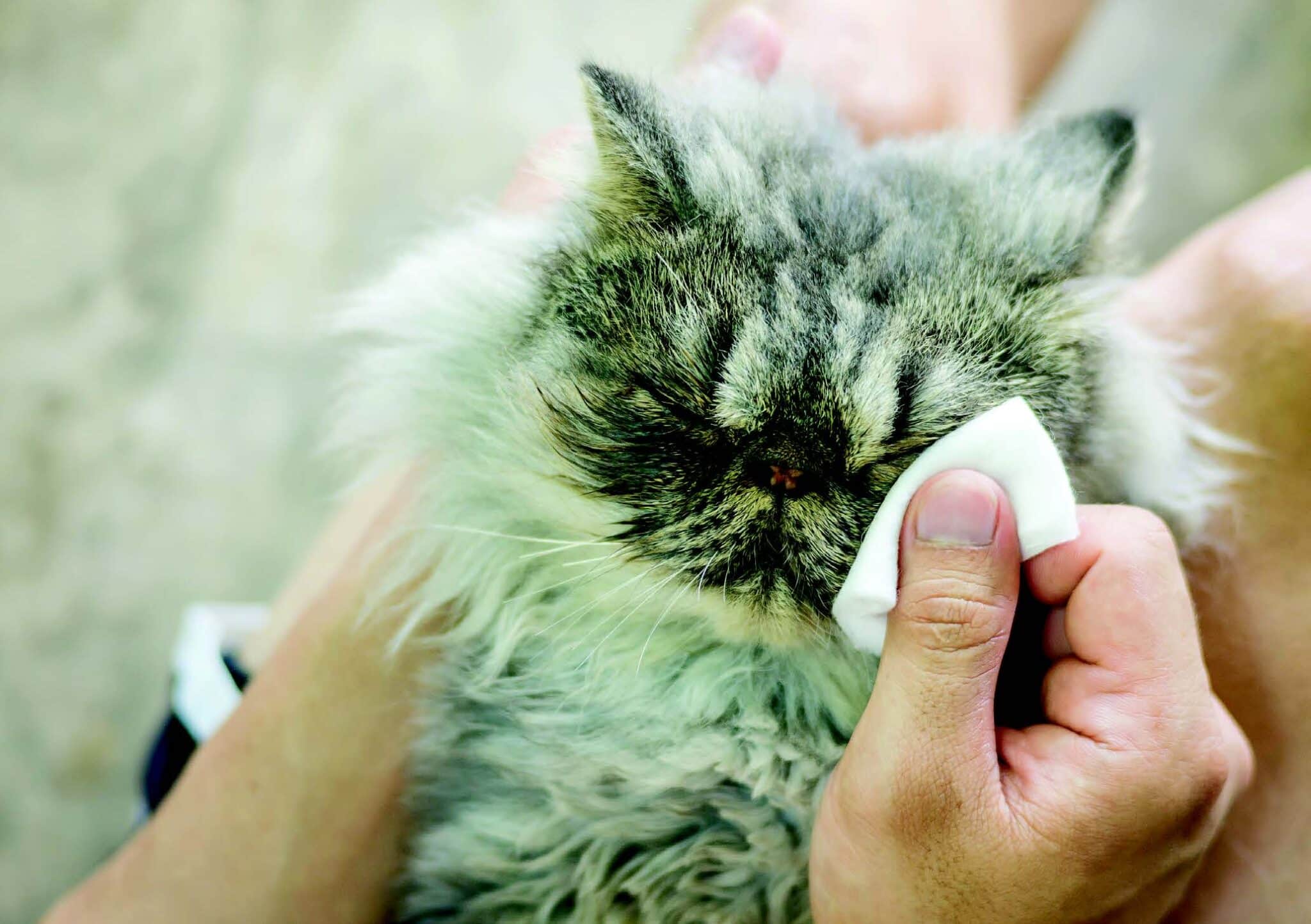Common Causes of Tearing
The medical term epiphora means excessive tearing. In general, when we investigate the reasons for epiphora, we can narrow it down to two broad categories: excessive tear production or inadequate tear drainage.
Tearing is the proper response by the eyes when something is irritating them. Dust, chemicals, smog and smoke can trigger an increase in tearing in cats, just like it does in humans. When the irritant goes away, the epiphora usually resolves. Sometimes, however, the irritant persists, and the tearing becomes chronic.
A common cause of epiphora in cats is a condition called entropion, which occurs when the eyelid (usually the lower lid) rolls inward. The fur on the eyelid will be in direct contact with the cornea. Anyone who’s ever gotten a grain of sand or a stray eyelash in their eye knows that the cornea is loaded with pain receptors, and the constant contact of the hair with the cornea leads to persistent tearing.
Applying ointment to the cornea can soothe the eye and helps form a barrier between the hair and the cornea, but this is just a temporary fix. The treatment of entropion is surgical: a wedge of skin below the affected eye is removed, and the edges of the defect are sutured together. This will cause the eyelid to roll back outward, taking the hair off of the cornea and giving the cat some relief.
Corneal ulcers (scratches or abrasions to the corneal surface) are another cause of epiphora. These are quite painful and will cause redness, squinting and tearing, and the cat will frequently rub at the eye. Left untreated, a corneal ulcer can persist and progress, and if the ulcer goes deep enough, the eye could rupture and vision could be lost. (More about corneal ulcers and their treatment in my column from last year’s September/ October issue of Catster, which is online at catster.com.) Infections, allergies and other types of eye injuries also cause excessive tear production.
Once we’ve ruled out the common causes of excessive tear production, we focus our attention on problems with tear drainage. Normally, tears drain from the eye into the cat’s nose and throat through a small duct located at the inner corner of the eye. Sometimes, the tears can’t drain because the opening of the duct is blocked. Cats who have had eye inflammation due to severe respiratory infections (often as kittens, especially if coming from a shelter or pet store) often develop scarring at the opening of the tear duct, preventing proper drainage.
If a blocked tear duct is suspected, a cannula can be inserted into the duct (with the cat under anesthesia, of course) to try to unblock it. Some cats have a blocked tear duct because the duct failed to open during the cat’s development. This can be corrected surgically. Brachycephalic cats (flat-faced breeds like Himalayans and Persians) usually have anatomical abnormalities of their tear ducts. This, along with their big eyes and shallow eye sockets, predisposes these breeds to epiphora. The tears fail to enter the tear duct and instead roll down their face.

©K_Thalhofer | Getty Images
Diagnosis and Treatment
Diagnosing a tear drainage problem in cats is easy (and is actually a little bit of fun). A drop of fluorescent yellow dye is placed in the cat’s eye. The tear duct runs from the corner of the eye to the nose. If the duct is open, the dye makes its way to the nose, and the cat’s nose will appear to glow in the dark under a black light. It looks freaky, and kids find it fascinating. (Adults, too!) If the nose doesn’t light up, we can’t say with 100% certainty that the tear duct is blocked, but it would surely warrant further investigation.
If an underlying cause for epiphora can be identified and treated, most cases resolve. Cats with anatomical issues, however, are probably destined to a life of watery eyes and wet faces. Tears do contain a small amount of pigment, and cats with light-colored fur may show some reddish-brown tear staining of the fur beneath the eyes. The staining is harmless, but many owners find it unsightly.
A variety of products are available to help minimize the staining; however, a veterinarian should be consulted beforehand, to make sure the product is safe and FDA approved. Products containing antibiotics should be avoided, as they can lead to bacterial resistance. I also recommend avoiding products with hydrogen peroxide, as this can be very irritating if it gets into the eye accidentally.
Dry Those Tears
Here’s a sampling of products available to help prevent tearing and stains. You’ll find tear stain prevention products on chewy.com and other pet supply retailers:

